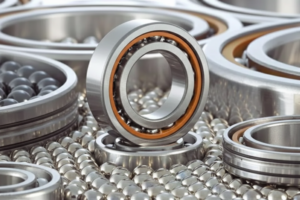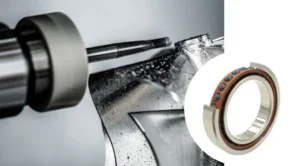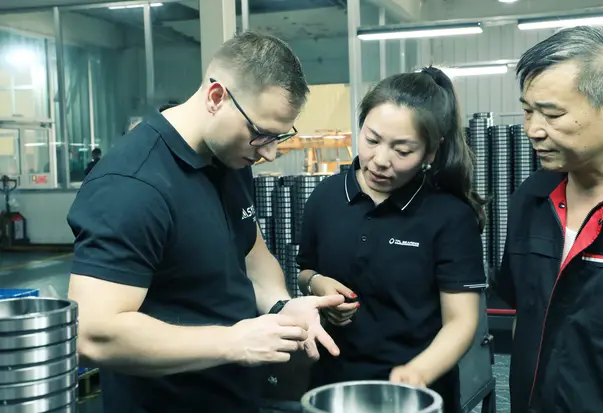Single row deep groove ball bearings are widely used in our life, but with so many types available, how do you know when to use them and which model to choose?
This article breaks down the key scenarios for selecting deep groove ball bearings and helps you pick the right one for your needs.
1. Understanding Single Row Deep Groove Ball Bearings
What Is a Single Row Deep Groove Ball Bearing?
A single row deep groove ball bearing has one set of balls running in deep grooves on the inner and outer rings. This design allows it to handle both radial (sideways) and light axial (thrust) loads. They’re widely used because of their simplicity and versatility.
Key parts:
- Inner/outer rings
- Steel or ceramic balls
- Cage (holds balls in place)
- Seals or shields (optional)

Key Advantages (vs. Other Bearings)
Single row deep groove ball bearings stand out from other bearings like double row or angular contact bearings in these ways:
- Compact Design for Tight Spaces
- Single row bearings are 30% thinner than double row bearings (ISO 15:2017), making them ideal for small motors or tools where space is limited.
- Example: Used in drone motors instead of bulkier double row bearings.
- Lower Cost for General Use
- Simpler design means 20–40% cheaper than angular contact bearings, which are better for heavy axial loads.
- Example: Choose these for household fans instead of pricier alternatives.
- Handles Both Radial and Light Axial Loads
- Unlike cylindrical roller bearings (radial-only), they can handle light push/pull forces along the shaft.
- Example: Supports both rotation and minor thrust in washing machine drums.
Common Applications (Specific Parts & Machines)
Here’s exactly where single row deep groove ball bearings are used:
- Electric Motors
- Part: Rotor shaft support (radial load).
- Machines: Vacuum cleaners, power drills, HVAC fans.
- Why here? Quiet operation and high-speed tolerance (up to 20,000 RPM).
- Automotive Systems
- Part: Alternator pulleys (radial + light axial load from belt tension).
- Avoid using in: Wheel hubs (heavy axial load; use tapered roller bearings instead).
- Home Appliances
- Part: Blender blade shafts (miniature bearings like 626ZZ, 10mm size).
- Yo-Yos
- Part: Central axle assembly.
- Why Here?: Single row bearings reduce friction, enabling 1–2 minute spin times (vs. 10 seconds with basic bushings). Miniature sizes (e.g., 8mm diameter) keep yo-yos lightweight for tricks.

2. Key Factors to Consider When Selecting
Load Capacity (Radial vs. Axial)
- Radial load: The weight pushing sideways.
- Axial load: The force pushing along the shaft.
- Data reference: Most single row bearings handle up to 20% of their radial load as axial load (ISO 15:2017 standard).
Choose bearings with higher load ratings if your machine faces heavy forces.
Operating Speed and Temperature
- Speed limit: Check the bearing’s maximum RPM.
- Temperature: Stainless steel bearings work best above 250°F (120°C).
Precision and Tolerance Levels
- ABEC ratings: ABEC 1 (standard) vs. ABEC 5 (high precision). Higher precision reduces vibration in CNC machines or robotics.
Sealing and Lubrication Options
- Open bearings: Require frequent lubrication.
- Sealed bearings: Pre-lubricated and dust-resistant.
3. Material and Design Specifications
Material Selection Guide
- Chrome steel: Affordable and durable (most common).
- Stainless steel: Resists rust in wet environments (e.g., food processing).
- Ceramic: Lightweight and heat-resistant (used in aerospace).
Bearing Series and Dimensions
- Standard “02” Series
- Example: 6204 Bearing
- Dimensions: Inner diameter = 20mm, Outer diameter = 47mm, Width = 14mm
- Example: 6305 Bearing
- Dimensions: 25mm (inner) × 62mm (outer) × 17mm (width).
- Example: 6204 Bearing
- Miniature Bearings
- Example: 626ZZ
- Dimensions: 6mm (inner) × 19mm (outer) × 6mm (width).
- Example: 608ZZ
- Dimensions: 8mm × 22mm × 7mm.
- Example: 626ZZ
- Extra-Thin “68” Series
- Example: 688 Bearing
- Dimensions: 8mm × 16mm × 5mm.
- Example: 688 Bearing
4. How to Match Bearings to Your Application
Industrial vs. Consumer Applications
- Industrial: Use heavy-duty bearings with seals.
- Consumer: Prioritize quiet operation.
Case Study Examples
- Electric motor: A sealed 6203 bearing reduced downtime by 30% in a factory.
Image suggestion: Side-by-side comparison of bearings in different applications.
5. Maintenance and Longevity Tips
Proper Installation
- Avoid hammering; use a press tool.
- Heat the bearing to 200°F (93°C) for easier fitting.
Lubrication Best Practices
- Re-grease every 6 months in high-use machines.

FAQ Section
Q: Can I use a single row bearing for heavy axial loads?
A: No—use angular contact bearings instead. Single row bearings handle only light axial loads.
Q: What’s the difference between open and sealed bearings?
A: Sealed bearings last longer but cost 20% more.




